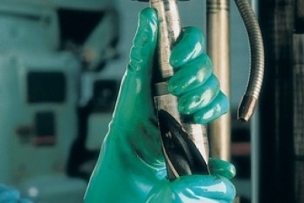Understanding the New ANSI 138 Hand Impact Standard
A recent webinar hosted by MCR Safety gave details on the new ANSI 138: 2019 standard for impact gloves.
The new ANSI/ISEA 138-2019 standard for back-of-hand protection, which went into effect in February 2019, established testing, classification and labeling requirements for gloves that offer impact resistance. Learn all about this new standard that will influence PPE decisions—and protect workers in new ways.
Michael Myrick, a safety training manager with MCR Safety, discussed the new PPE standard ANSI/ISEA 138-2019: American National Standard for Performance and Classification for Impact-Resistant Gloves in a recent webinar in partnership with MSC. MCR Safety is one of the companies that helped develop the industry standards.
During the webinar, Myrick discussed how the standard was developed, how gloves are tested and how it will assist safety managers with choosing the right impact gloves.
ANSI 138: The New Impact-Rated Glove Standard
According to Myrick, starting in 2017, the International Safety Equipment Association and the American National Standards Institute began collaborating on the impact glove standard. They consulted with research facilities and hand surgeons, among others, and used cadaver hands to study how much kinetic energy is required to break or crack bones.
“I’ve always called the back of the hand ‘the forgotten zone,’” Myrick said during the webinar. “Now you can take [the research] and focus on back-of-hand protection like never before.”
How Impact-Rated Glove Tests Are Conducted
In order to qualify as impact gloves under the new standard, gloves must be tested at a third-party lab; glove manufacturers cannot do their own testing. Gloves may be found to offer insufficient protection to qualify as impact-resistant gloves, or they may be rated at one of three performance levels based on the protection offered to the knuckles, the thumb and the fingers.
Myrick said during testing, gloves are taken apart—the front removed from the back—so only the back part of the glove is tested. The glove is placed in a drop rig that allows researchers to drop an anvil on the part of the glove being tested.
Underneath the glove is an apparatus that measures the amount of force that is transmitted through the material of the glove and relays that information back to a computer.
“There’s no way that someone can say: ‘That didn’t hurt as bad so it must be a 2,’” Myrick said. “This is going to be information that is calibrated and tested via a computer.”
The “peak transmitted force” (PTF), expressed in kilonewtons (kN), measures the energy absorbed by the glove; the lower the PTF, the more energy the glove is absorbing and the higher its ANSI rating.
On the thumb, index finger and ring finger, gloves are tested 25 millimeters from the top of the glove. On the middle finger and the pinky, they are tested 50 millimeters from the top of the glove. For accuracy, Myrick said, the knuckle test area is determined by having three different large-size glove users put on gloves and grip a standard testing tube. The location of their knuckles is marked with a triangle and the center of the triangle is tested.
What Happens After Testing Impact-Rated Gloves
The testing results are used to place gloves in one of three categories. Level 1 gloves offer the least amount of protection, while Level 3 gloves offer the most.
To achieve a Level 2 rating, all parts of the glove being tested must meet the Level 2 standard. A glove meeting the Level 2 standard for the knuckles and fingers but a Level 1 standard for the thumb will only get a Level 1 rating.
Confused by the different types of gloves—especially the new standards? There is help. Read “Impact Gloves vs. Vibration-Resistant Gloves: What’s the Difference?”
Classification for impact resistance (table)
Performance level Mean (kN) All impacts (kN)
1 ≤9 <11.3
2 ≤6.5 ≤8.1
3 ≤4 ≤5
Manufacturers now need to include a pictograph showing the glove’s impact rating either on the glove itself or on a label attached to the glove. Either way, the label is required to last the lifetime of the glove.
“If you say or you advertise it’s an impact glove, you have to have the impact rating, the data on your website, on a spec sheet, on flyers, whatever, and have it on the glove,” Myrick said, adding that the information will be helpful to safety managers trying to choose the right gloves for their workers.
To learn more about the glove materials, coatings, cut levels and cut ratings, explore this page complete with a diagram: Tech Essentials: Cut and Puncture Resistant Gloves.
Impact-Rated Gloves Will Drive Product Advances
The challenge for glove manufacturers, Myrick said, will be to come up with gloves that offer Level 3 protection but are not too bulky or heavy.
“When you look at the different gloves out in the industry, there’s not going to be a lot of Level 2 and Level 3 products out there that are very comfortable,” he said. “Most companies are having to make their material thicker in order to meet this standard.”
Myrick said manufacturers will also be doing a lot of redesign. Gloves that were formerly marketed as being impact-resistant but that don’t meet at least the new Level 1 standard will no longer be able to use that designation. They can either be repurposed as gloves for another use or modified until they meet the new standard.
“I think what you’re going to see over the next few years, just like we’ve seen in cut resistance, there’s going to have to be some advancement in materials in order to keep those materials thin and still be able to meet that impact Level 3,” Myrick said.
"I’ve always called the back of the hand ‘the forgotten zone.’ Now you can take [the research] and focus on back-of-hand protection like never before.”
Where to Start: Review Workplace Accident Logs
Myrick also addressed when gloves are needed and which level of glove is used for different tasks.
For facilities, he recommended reviewing accident logs for hand injuries—including bruises, crush injuries or broken bones—and checking to see whether workers are losing work time to hand injuries.
“Your general construction, your general industry situation, lumber, plumbing, ironworkers, where they’re getting the metal rolling on the backs of their hands, that’s a Level 1, that’s bumps and bruises,” Myrick said.
Workers in industries such as oil and gas, lumber, general construction, plumbing or ironworking, however, should be using Level 2 gloves.
Do you know what level of impact gloves your workers need?





Talk to Us!
Leave a reply
Your email address will not be published. Required fields are marked *